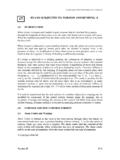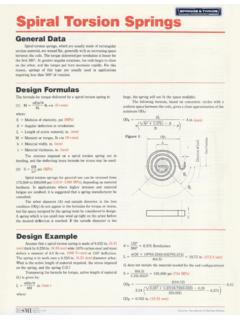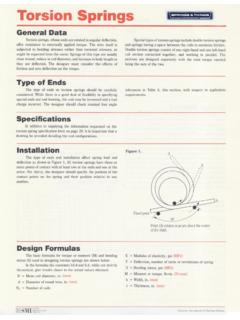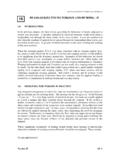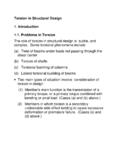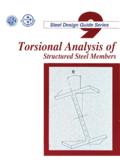Transcription of General Relativity with Torsion - Slimy.com
1 General Relativitywith Torsion :Extending Wald s Chapter on CurvatureSteuard Jensen Enrico Fermi Institute and Department of PhysicsUniversity of Chicago5640 S. Ellis Avenue, Chicago IL 60637, USAN ovember 16, 2005 AbstractMost applications of differential geometry, including General rela-tivity, assume that the connection is Torsion free : that vectors donot rotate during parallel transport. Because some extensions of GR(such as string theory) do include Torsion , it is useful to see how torsionappears in standard geometrical definitions and formulas in modernlanguage. In this review article, I step through chapter 3, Curva-ture , of Robert Wald s textbookGeneral Relativityand show whatchanges when the Torsion -free condition is Introduction22 Defining Torsion23 Curvature (with Torsion ) Derivative Operators and Parallel Transport.
2 Curvature .. Geodesics .. Methods for Computing Curvature .. Coordinate Component Method .. Orthonormal Basis (Tetrad) Methods .. 14A B-Fields and Non-symmetric Metrics15B Differential Forms, et Differential Forms .. 16 Electronic address: November 16, 2005; CVS $Revision: $Date: 2005/11/16 22:24:09 GMT21 IntroductionRobert Wald s textbookGeneral Relativity [1], like most work on differentialgeometry, includes the assumption that derivative operators aare torsionfree : for all smooth functionsf, a bf b af= 0. This propertycorresponds intuitively to the condition that vectors not be rotated by paralleltransport.
3 Such a condition is natural to impose, and the theory of generalrelativity itself includes this , differential geometry is equally well defined with Torsion as with-out, and some extensions of General Relativity include Torsion terms. The firstof these was Einstein-Cartan theory , as introduced by Cartan in 1922 [2](translated to English with commentary as an appendix to [3]). One reviewof work in this area is [4]. Of greater current interest, the low energy limitof string theory includes a massless 2-form field whose field strength playsthe role of Torsion . While Torsion can always be treated as an independenttensor field rather than as part of the geometry, the latter approach can bemore efficient and may potentially give greater insight into the have written this document primarily for my own reference, but I amhappy to share it with others.
4 It is written with the assumption that thereader has a copy of Wald s book close at hand; I have not attempted tomake it stand on its own. (Readers with a decent knowledge of GR maybe able to follow most of it unaided.) I have tried to provide appropriategeneralizations of every numbered equation in chapter 3 ( Curvature ) thatchanges in the presence of Torsion ; in the handful of cases where I have simplydescribed the change in the text, the equation number is printed inbold. (Ihave also done this for appendix on differential forms.) Any equation notshown with a correction here remains unchanged in the presence of have done my best to avoid mistakes in either presentation or results, butI will be grateful for any corrections or feedback on what Defining TorsionAs with most geometric concepts, there are several ways to define Wald s presentation, I will define it in terms of the commutatorof derivative operators.
5 (The formulas are provided here for reference; I willexplain them in more detail as they arise over the course of the chapter.) Asexplained in the footnote on Wald s p. (31), the Torsion of a connection isTypeset November 16, 2005; CVS $Revision: $Date: 2005/11/16 22:24:09 GMT3characterized by the Torsion tensorTcab, which is defined by a bf b af= Tcab cffor any smooth functionf. It is also directly related to commutators ofvector fields,[v,w]c=va awc wa avc Tcabvawb,and to an antisymmetric component in the Christoffel symbols,2 c[ab]= cab cba= string theory, the field strength of the massless 2-form fieldBabis thenegative of the Torsion as defined above:3 [aBbc]=Habc= Tabc.
6 (In the language of differential forms,H=dB.) This form is considerablymore constrained than General Torsion (which need not even be antisymmetricon all three covariant indices), and this will not be our definition in most ofwhat follows. A few further comments on this are given in appendix Curvature (with Torsion )The section and equation numbers here are set to match those in Wald sbook. When those equations are not altered by the presence of Torsion , theywill not be given here, so the numbering may jump Derivative Operators and Parallel TransportThe first change to Wald s presentation must be to omit the Torsion free con-dition (his condition 5) when defining a derivative operator.
7 Problem his book asks the reader to show the existence of the Torsion tensor (andgives a hint on how to do so, by echoing the derivation of the change ofderivative tensorCcab). The proof is not difficult, so to avoid doing people shomework for them I will simply cite the result here: a bf b af= Tcab November 16, 2005; CVS $Revision: $Date: 2005/11/16 22:24:09 GMT4 This formula comes straight from the footnote to condition 5. The torsionis antisymmetric in its second and third indices, but in General no symmetryinvolving the first index is required at noted in Problem , the formula for the commutator of two vectorfields changes in the presence of Torsion .
8 [v,w](f) =va a(wb bf) wa a(vb bf)= (va awb wa avb) bf vawbTcab cf,( )where we have simply applied the Leibnitz rule. This leads to the modifiedexpression[v,w]c=va awc wa avc Tcabvawb.( )Wald s derivation of the tensorCcabrelating two derivative operators isunchanged in the presence of Torsion , but the symmetry of that tensor is the commutator of Eq. ( ) under exchange ofaandbyields:( a b b a)f= ( a b b a)f (Ccab Ccba) cf(where of course cand care equal when applied tofin the final term).Substituting the definition of Torsion in the first two terms shows that thecommutator isCcab Ccba=Tcab Tcab( Tcab).
9 ( )If the two derivative operators have equal Torsion , then these coefficients willhave the usual expressions showing howCcabrelates derivative operators when ap-plied to General tensors are unchanged by the presence of Torsion . And withthe Torsion -free condition relaxed, anyCcabwill define a new derivative opera-tor, regardless of its symmetry. In particular, the definition of the Christoffelsymbol cabwill now also incorporate definition of parallel transport is not changed in the presence of tor-sion, and it still defines a connection on the manifold. But when seekinga derivative operator compatible with the metricgab, Torsion remains un-constrained.
10 Requiring that parallel transport leave inner productsgabvawbinvariant essentially means that the vectors lengths and angles relative toone another must be unchanged from point to point. But this does not spec-ify anything about global rotations of the tangent space during paralleltransport: that is the physical meaning of November 16, 2005; CVS $Revision: $Date: 2005/11/16 22:24:09 GMT5 When we allow derivative operators with Torsion , the statement of The-orem must be modified as explained in Problem :Theorem a metric andTcabbe a Torsion . Then there existsa unique derivative operator awith this Torsion satisfying agbc= s proof holds as written up through Eq.

